From » The Ray McVay Road Show »
Label: Philips — 6308.207
Format: Vinyl, LP
Country: UK
Released: 1974
Tracklist
A1 Theme From »2001»
A2 The Peanut Vendor
A3 Theme From »Shaft»
A4 Ma! He’s Making Eyes At Me
A5 Little Brown Jug
A6 Spanish Eyes
A7 Oh Babe
B1 Popcorn
B2 Everybody Get Ready
B3 E Viva Espaρa
B4 Kalinka
B5 I Don’t Know How To Love Him
B6 Ave Maria
B7 Michael Row The Boat Ashore
B8 Matrimony
————————
Also sprach Zarathustra, Op. 30 (Thus Spoke Zarathustra or Thus Spake Zarathustra) is a tone poem by Richard Strauss, composed in 1896 and inspired by Friedrich Nietzsche’s philosophical treatise of the same name.
The composer conducted its first performance on 27 November 1896 in Frankfurt.
A typical performance lasts half an hour.
The work has been part of the classical repertoire since its first performance in 1896.
The initial fanfare — entitled «Sunrise» in the composer’s program notes — became particularly well known to the general public due to its use in Stanley Kubrick’s 1968 film 2001: A Space Odyssey, and as the theme music of the Apollo program.
The fanfare has also been used in many other productions.
Instrumentation
The orchestra consists of the following:
woodwinds: piccolo, 3 flutes (3rd doubling piccolo), 3 oboes, English horn, 3 clarinets in E-flat and B-flat, bass clarinet in B-flat, 3 bassoons, contrabassoon
brass: 6 horns in F, 4 trumpets in C, 3 trombones, 2 tubas
percussion: timpani (2 players), bass drum, cymbals, triangle, glockenspiel, bell on low E
keyboard: organ
strings: 2 harps, violins i, ii (16 each), violas (12), cellos (12), double basses (8) (several with low C string).
Structure
The piece is divided into nine sections played with only three definite pauses.
Strauss named the sections after selected chapters of the book:
Einleitung, oder Sonnenaufgang (Introduction, or Sunrise)
Von den Hinterweltlern (Of Those in Backwaters)
Von der großen Sehnsucht (Of the Great Longing)
Von den Freuden und Leidenschaften (Of Joys and Passions)
Das Grablied (The Song of the Grave)
Von der Wissenschaft (Of Science and Learning)
Der Genesende (The Convalescent)
Das Tanzlied (The Dance Song)
Nachtwandlerlied (Song of the Night Wanderer)
The piece starts with a sustained double low C on the double basses, contrabassoon and organ.
This transforms into the brass fanfare of the Introduction and introduces the «dawn» motif (from «Zarathustra’s Prologue», the text of which is included in the printed score) that is common throughout the work: the motif includes three notes, in intervals of a fifth and octave, as C–G–C (known also as the Nature-motif).
On its first appearance, the motif is a part of the first five notes of the natural overtone series: octave, octave and fifth, two octaves, two octaves and major third (played as part of a C major chord with the third doubled).
The major third is immediately changed to a minor third, which is the first note played in the work (E flat) that is not part of the overtone series.
«Of Those in Backwaters» (or «Of the Forest Dwellers») begins with cellos, double-basses and organ pedal before changing into a lyrical passage for the entire section.
The next two sections, «Of the Great Yearning» and «Of Joys and Passions», both introduce motifs that are more chromatic in nature.
«Of Science» features an unusual fugue beginning in the double-basses and cellos, which consists of all twelve notes of the chromatic scale.
It is one of the very few sections in the orchestral literature where the basses must play a contra-b (lowest b on a piano).
«The Convalescent» acts as a reprise of the original motif, and climaxes with a massive chord in the entire orchestra.
«The Dance Song» features a very prominent violin solo throughout the section.
The end of the «Song of the Night Wanderer» leaves the piece half resolved, with high flutes, piccolos and violins playing a B major chord, while the lower strings pluck a C.
One of the major compositional themes of the piece is the contrast between the keys of B major, representing humanity, and C major, representing the universe. Because B and C are adjacent notes, these keys are tonally dissimilar: B major uses five sharps, while C major has none.
Recordings
In 1944, Strauss conducted the Vienna Philharmonic in an experimental high fidelity recording of the piece, made on a German Magnetophon tape recorder.
This was later released on LP by Vanguard Records and on CD by various labels.
Strauss’s friend and colleague, Fritz Reiner, made the first stereophonic recording of the music with the Chicago Symphony Orchestra in March 1954 for RCA Victor.
In 2012, this album was added to the Library of Congress’s National Recording Registry list of «culturally, historically, or aesthetically important» American sound recordings.
The recording of the opening fanfare used for 2001: A Space Odyssey was a 1959 Decca Records session with Herbert von Karajan and the Vienna Philharmonic.



























































